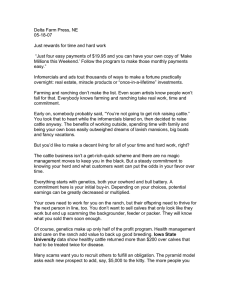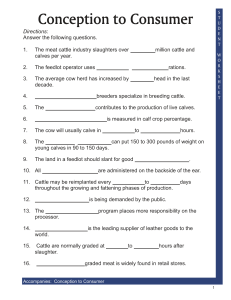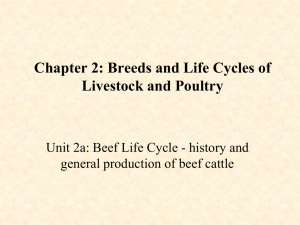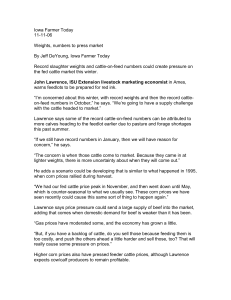CattleNetwork.com, KS 05-01-07 Certified Angus Beef: Black Ink - Not so fast
advertisement
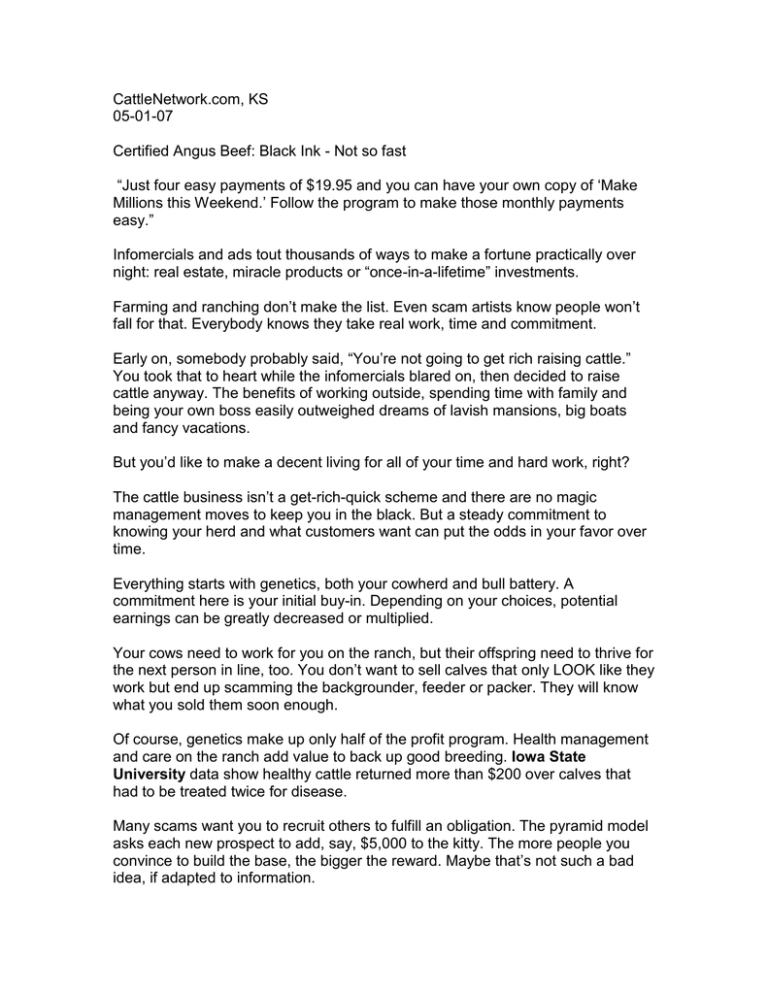
CattleNetwork.com, KS 05-01-07 Certified Angus Beef: Black Ink - Not so fast “Just four easy payments of $19.95 and you can have your own copy of ‘Make Millions this Weekend.’ Follow the program to make those monthly payments easy.” Infomercials and ads tout thousands of ways to make a fortune practically over night: real estate, miracle products or “once-in-a-lifetime” investments. Farming and ranching don’t make the list. Even scam artists know people won’t fall for that. Everybody knows they take real work, time and commitment. Early on, somebody probably said, “You’re not going to get rich raising cattle.” You took that to heart while the infomercials blared on, then decided to raise cattle anyway. The benefits of working outside, spending time with family and being your own boss easily outweighed dreams of lavish mansions, big boats and fancy vacations. But you’d like to make a decent living for all of your time and hard work, right? The cattle business isn’t a get-rich-quick scheme and there are no magic management moves to keep you in the black. But a steady commitment to knowing your herd and what customers want can put the odds in your favor over time. Everything starts with genetics, both your cowherd and bull battery. A commitment here is your initial buy-in. Depending on your choices, potential earnings can be greatly decreased or multiplied. Your cows need to work for you on the ranch, but their offspring need to thrive for the next person in line, too. You don’t want to sell calves that only LOOK like they work but end up scamming the backgrounder, feeder or packer. They will know what you sold them soon enough. Of course, genetics make up only half of the profit program. Health management and care on the ranch add value to back up good breeding. Iowa State University data show healthy cattle returned more than $200 over calves that had to be treated twice for disease. Many scams want you to recruit others to fulfill an obligation. The pyramid model asks each new prospect to add, say, $5,000 to the kitty. The more people you convince to build the base, the bigger the reward. Maybe that’s not such a bad idea, if adapted to information. No, you don’t want to trick people into putting cash at risk, but convince buyers to add to the information base. If your calves go to a backgrounder, add the data background they need to succeed. Ask that they add to the kitty and pass it along to the feedyard, which should try to add performance and carcass data in the end. If you feed your cattle at home, see if the buyers will share information. It can’t hurt to ask—the more people who ask, the more likely the information pyramids will start to take shape. Meanwhile, all of this focus could lead to premiums in the sale barn, whether you’re selling feeder calves or fat cattle. Another option with more risk and reward is to sell your finished cattle on a grid. It might look like another get-rich-quick scheme, with all those premium opportunities and stories you read about people earning $100 per head above the cash market. The only trick is that it takes time and commitment to avoid losing money. It takes knowledge of what your cattle can do and the ability to sell when they have the best chance to do it. Gridding unknowns can be like falling for a scam or just another losing lottery ticket. Some programs promise “instant financial freedom,” but those hoaxes are here one day and gone the next. You want something that lasts, and that’s why you built with physical and mental effort. It’s always going to take real work, but the market does pay premiums if you pay more attention to quality. It may not be as easy as dialing a 900 number or watching a video, but making a plan for your herd is probably a surer bet than the quick million. Imagine the satisfaction of knowing you helped produce millions of pounds of high-quality beef over your lifetime. You made tens of millions of beef consumers across the globe want to come back for more. You helped keep ranching a viable way of life for the next generation. It might sound too good to be true, but in the real world, that’s how it works. Next time in Black Ink, Steve Suther will look at how to view bad news. Questions? Call toll-free at 877-241-0717 or e-mail mreiman@certifiedangusbeef.com. Source: Miranda Reiman, Certified Angus Beef
